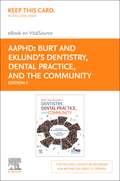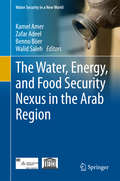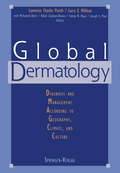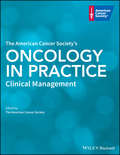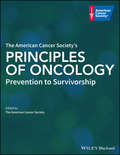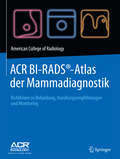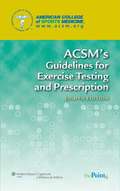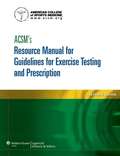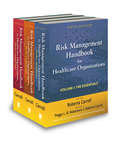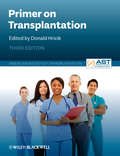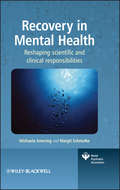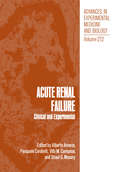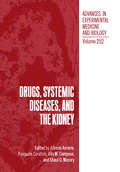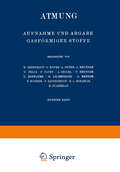- Table View
- List View
Burt and Eklund’s Dentistry, Dental Practice, and the Community - E-Book
by Amer Assoc of Public Health DentistryLearn about the challenges, current trends, and the positive role that you can play in improving the dental health of the community. Completely revised and updated by members of the American Association of Public Health Dentistry, Burt and Eklund's Dentistry, Dental Practice, and the Community, 7th Edition presents dentistry and dental practice against the ever-changing backdrop of economic, technological, and demographic trends, as well as the distribution of the oral diseases that dental professionals treat and prevent. Readers will learn the latest techniques of research and measurement, and how oral disease may be limited through control and prevention. This updated text also addresses the new educational competencies for predoctoral/ post-doctoral dental students and dental hygiene students with updated and new content on cultural competency, oral health literacy, social responsibility, motivational interviewing, and oral systemic associations. All in all, this text takes a comprehensive look at the social context of dental care and the difference you can make in improving the health of the community you serve.Logical four-part organization divides content into dentistry and the community; dental care delivery; methods and measurement of oral diseases and conditions; and health promotion and prevention of oral diseases.A focus on need-to-know content emphasizes the important core information while providing comprehensive coverage of dental public health.Comprehensive analysis of dentistry’s social and professional role examines issues such as epidemiology of oral diseases, prevention, and the provision of care.Evidence-based recommendations reflect the latest literature on today’s public health issues.Illustrations, tables, and graphics illustrate the key material and visually enhance discussions.NEW! Completely revised and updated content looks at populations oral health and dental care as well as how it fits into a changing world.NEW! Coverage of new educational competencies provides predoctoral/ post-doctoral dental students and dental hygiene students with updated and new content on cultural competency, oral health literacy, social responsibility, motivational interviewing, and oral systemic associations.NEW! New chapters cover the applications of epidemiology and biostatistics in dental public health, oral health as it related to quality of life, oral health education, health literacy, social determinants of health and health disparities, and delivery of oral healthcare in Canada.NEW! Newly revised competencies for the Dental Public Health specialty are incorporated throughout the book.
The Water, Energy, and Food Security Nexus in the Arab Region (Water Security in a New World)
by Kamel Amer Zafar Adeel Benno Böer Walid SalehThis book investigates the need for a more open and interdisciplinary dialogue on the nexus of food, water and energy security in the Arab region. It argues that achieving sustainable economic development is irretrievably tied to the security of the water–energy–food nexus, which is in turn essential for bringing about sustained peace. Further, it discusses various approaches to achieving these lofty objectives, and offers the following take-away messages:The Arab region is currently under considerable water stress, and the situation will continue to get worse with a number of global changes – most notably those related to climate and regional water distribution.Viable solutions are available in the Arab region and can be implemented through innovative policies, judicious use of new technologies, and stimulating public opinion.Integration across water, energy, and food sectors is obviously needed but achieving it in practice is extremely challenging.There are some gaps in the scientific understanding but at the same time there is a wealth of data and synthesized information that can guide decision-making.
Global Dermatology: Diagnosis and Management According to Geography, Climate, and Culture
by M. Amer R.A.C. Graham-Brown S. N. Klaus J. L. PaceA comprehensive source of information on variations found in skin diseases throughout the world is offered here. By considering the overall problems of hereditary variables, climate fluctuations, and therapeutic differences, this volume provides an appraisal of the diverse factors that make up the composite picture of cutaneous medicine. Divided by continent and then further organized into countries or regions, each entry presents basic information on the disease indigenous to the area, including its definition and symptoms, etiology, clinical manifestations, histopathology, appropriate laboratory tests, differential diagnosis, management, prevention and references. Additional chapters discuss the influence of travel and migration as well as of variables such as climate. 38 full color plates superbly illustrate the many variations of major dermatologic diseases. As technology has made global travel far quicker and more commonplace, this book is a must for all dermatologists, infectious disease specialists, and for all family practitioners and general internists.
The American Cancer Society's Oncology in Practice: Clinical Management
by American Cancer SocietyDeveloped by the American Cancer Society this new textbook designed for a wide range of learners and practitioners comprehensively addresses all aspects of clinical management for cancer taking a balanced, authoritative and, -where possible- evidence-based stance and may be used in conjunction with the book, The American Cancer Society's Principles of Oncology: Prevention to Survivorship. Edited by leading clinicians in the field and a stellar contributor list from the US and Europe, this book is written in an easy to understand style by multidisciplinary teams of medical oncologists, radiation oncologists and other specialists, reflecting day-to-day decision-making and clinical practice. Input from pathologists, surgeons, radiologists, and other specialists is included wherever relevant and comprehensive treatment guidelines are provided by expert contributors where there is no standard recognized treatment. This book is an ideal resource for anyone seeking a practical understanding of the field of oncology.
The American Cancer Society's Principles of Oncology: Prevention to Survivorship
by American Cancer SocietyDeveloped by the American Cancer Society this new textbook designed for a wide range of learners and practitioners is a comprehensive reference covering the diagnosis of cancer, and a range of related issues that are key to a multidisciplinary approach to cancer and critical to cancer control and may be used in conjunction with the book, The American Cancer Society's Oncology in Practice: Clinical Management. Edited by leading clinicians in the field and a stellar contributor list from the US and Europe, this book is written in an easy to understand style by multidisciplinary teams of medical oncologists, radiation oncologists and other specialists, reflecting day-to-day decision-making and clinical practice. Input from pathologists, surgeons, radiologists, and other specialists is included wherever relevant and comprehensive treatment guidelines are provided by expert contributors where there is no standard recognized treatment. This book is an ideal resource for anyone seeking a deeper understanding of cancer prevention, screening, and follow-up, which are central to the ACS's worldwide mission on cancer control.
ACR BI-RADS®-Atlas der Mammadiagnostik: Richtlinien zu Befundung, Handlungsempfehlungen und Monitoring
by American College American College of RadiologyDieses Buch ist die offiziell genehmigte, deutsche Übersetzung des ACR BI-RADS®-Atlas in seiner fünften Auflage. Der ACR BI-RADS®-Atlas ist ein qualitätssicherndes Werkzeug zur Standardisierung des Berichtswesens, der Unklarheiten in der Befundung der Mammadiagnostik wie auch bei den Vorschlägen zum weiteren Vorgehen verringern soll. Er macht die Ergebnisse von Instituten wie auch von einzelnen Befundern vergleichbarer und leichter kontrollierbar und verbessert somit die Versorgungsqualität für die Patientinnen. Inhalt: Der ACR BI-RADS®-Atlas umfasst das Spektrum der in der Praxis etablierten und wissenschaftlich fundierten Bildgebung der Mamma und besteht aus vier Teilen Mammografie, Sonographie der Mamma, Magnetresonanztomografie der Mamma sowie Nachkontrolle und Ergebnisüberwachung, in dem das klinisch relevante Audit und das erweiterte Audit der medizinischen Qualitätskontrolle erläutert werden. Nach einem jeweils einführenden Kapitel zu den drei bildgebenden diagnostischen Methoden folgt ein Atlasteil mit klaren Angaben zu den diagnostischen Kriterien wie Form, Rand, Verkalkungen, Kriterien der Kontrastmittelaufnahme etc., die sich durch klare Definitionen und einheitliche Benennungen auszeichnen. Für jedes Beschreibungskriterium wird hochqualitatives Bildmaterial gezeigt. Danach erläutert jeweils ein Kapitel, wie ein Befund erstellt werden sollte. Ziel ist es, anhand einer klaren und eindeutigen Diktion ohne adjektivische Ausschmückungen die Malignitätswahrscheinlichkeit einer Veränderung einzustufen, die sog. Festlegungskategorien 0-6 nach BI-RADS®, und auf dieser Grundlage ebenso klare Handlungsempfehlungen zur weiteren Aufarbeitung auszusprechen, die vom Vergleich mit Voraufnahmen über weitere bildgebende Diagnostik bis zur Empfehlung der Gewebediagnose mittels Biopsie reichen. Eingehend werden die Unterschiede von Screening- und diagnostischen Kategorisierungen abgehandelt. Der Leser findet jeweils im Kapitel "Hilfestellung" praktischen Rat zur Anwendung der deskriptiven Terminologie der einzelnen Verfahren, zur richtigen Verwendung der BI-RADS® Kategorien und zur Konkordanz von Befund und Handlungsempfehlung, abgeschlossen durch ein Schlusskapitel mit häufig gestellten Fragen und den Antworten darauf. Am Ende der diagnostischen Kapitel stehen komprimierte Formblätter, die dem Leser als Vorlage zu seinem Befundungssystem dienen können. Damit geht dieses Buch weit über den Rahmen eines Atlas hinaus, es ist eine große normative Hilfe für alle Probleme der Screening- und der diagnostischen Bildgebung.
Acsm's Guidelines For Exercise Testing And Prescription (PDF)
by American College of Sports Medicine (ACSM) StaffThe single most internationally read and referenced text in sports medicine, exercise science, and health and fitness, this manual succinctly summarizes recommended procedures for exercise testing and exercise prescription in healthy and diseased individuals. This gold-standard text is a convenient, one-stop resource for the knowledge, skills, and abilities (KSAs) that must be mastered by candidates for all ACSM certifications. Written by international experts in numerous fields, the Eighth Edition is fully compatible with newly released physical activity guidelines from the United States Department of Health and Human Services and state-of-the-art, research-based recommendations. A companion Website for instructors will offer a test generator, an image bank, PowerPoint slides, and a WebCT/BlackBoard-ready course cartridge. A student Website will offer the fully searchable text.
ACSM's Resource Manual For Guidelines For Exercise Testing And Prescription (PDF)
by American College of Sports Medicine (ACSM) StaffACSM's Resource Manual for Guidelines for Exercise Testing and Prescription was created as a complement to ACSM's Guidelines for Exercise Testing and Prescription and elaborates on all major aspects of preventative rehabilitation and fitness programs and the major position stands of the ACSM. The 7th edition provides information necessary to address the knowledge, skills, and abilities set forth in the new edition of Guidelines, and explains the science behind the exercise testing and prescription. ACSM's Resource Manual is a comprehensive resource for those working in the fitness and clinical exercise fields, as well as those in academic training. Highlights include: #65533; An expanded behavior change section with the tools needed to motivate people to begin exercise and then adhere to a program #65533; Content reflects the most recent research findings in the field as well as ACSM position stands
Joint Meeting: Special Reprint of the Gynecological Section (Deutsche Gesellschaft für Chirurgie)
by American College of Surgeons <Chicago, Ill. >. Josef Zander Deutsche Gesellschaft für ChirurgieExposure Assessment for Epidemiology and Hazard Control
by American Conference of Governmental Industrial HygienistsWhat agents should be measured?How should measurement be performed and what averaging time should be used for the measurement?What sampling strategy should be employed to characterize exposures across individuals, locations, and time?What durations of exposure should be characterized?What statistical descriptors should be used to relate exposure to effect?Exposure Assessment for Epidemiology and Hazard Control examines various approaches to answering these and other important questions. Other topics discussed include the measurement of current exposures (e.g., vapors, gases, aerosols, and complex mixtures); the application of toxicological relationships, including biological markers and sample models; an epidemiological evaluation of exposure-effect relationships, including new methods for effect evaluation and models for population exposure estimates; and strategies for exposure assessment, such as biological sampling interpretation through toxicokinetic processes. This important new volume contains essential information for industrial hygienists, epidemiologists, occupational health physicians, toxicologists, and immunologists.
Exposure Assessment for Epidemiology and Hazard Control
by American Conference of Governmental Industrial HygienistsWhat agents should be measured?How should measurement be performed and what averaging time should be used for the measurement?What sampling strategy should be employed to characterize exposures across individuals, locations, and time?What durations of exposure should be characterized?What statistical descriptors should be used to relate exposure to effect?Exposure Assessment for Epidemiology and Hazard Control examines various approaches to answering these and other important questions. Other topics discussed include the measurement of current exposures (e.g., vapors, gases, aerosols, and complex mixtures); the application of toxicological relationships, including biological markers and sample models; an epidemiological evaluation of exposure-effect relationships, including new methods for effect evaluation and models for population exposure estimates; and strategies for exposure assessment, such as biological sampling interpretation through toxicokinetic processes. This important new volume contains essential information for industrial hygienists, epidemiologists, occupational health physicians, toxicologists, and immunologists.
Nutrition and Cancer Prevention: New Insights into the Role of Phytochemicals (Advances in Experimental Medicine and Biology #492)
by American Institute American Institute for Cancer ResearchRecent advances have contributed to our understanding of how a plant-based diet confers many health advantages and how substances from plants may be effective in the prevention of specific cancers. The Ninth Annual Research Conference of the American Institute for Cancer Research has focused on the latest developments in several categories of nutrients of wide contemporary interests. The conference sessions included such topics as the effects of soy, green tea, selenium, wine, grapes, and spices in cancer prevention. This conference was held in Washington, D.C. on September 2nd and 3rd, 1999, and was entitled Nutrition and Cancer Prevention: New Insights Into the Roles of Phytochemicals. The discussion program included a session that was devoted to the current status of herbal products in relation to cancer prevention, in recognition of the increasing attention that complementary and alternative medicine has been receiving from the scientific community as well as the general public. A separate presentation addressed the issue of nutritional supplements and cancer prevention.
Colon Cancer Prevention: Dietary Modulation of Cellular and Molecular Mechanisms (Advances in Experimental Medicine and Biology #470)
by American Institute for Cancer ReseaThe Eighth Annual Research Conference of the American Institute for Cancer Research, held in Washington, D.C., September 3-4, 1998, was on the subject "Colon Cancer Prevention: Dietary Modulation of Cellular and Molecular Mechanisms," with participants representing various disciplines interested in this area. One of the speak ers provided an appropriate quote from 17th century physician Thomas Adams: "Pre vention is better than healing because it saves the labor of being sick," which aptly describes the need for the prevention of cancer. An overview of normal and abnormal colonic development emphasized that although the typical human colon undergoes 1013 cell divisions by age 60, with the asso ciated possibilities for error, relatively few colon tumors develop. Since dietary modu lation leads to extremely small changes in colonic cells over a long period, animal models are useful to time, observe, and delineate the events associated with colon cancer. In the development colon cancer, the inactivation of the adenomatous polyposis coli (Apc) gene is one of the earliest known events. Normally Apc downregulates the cellular protein beta-catenin, but this is lost during cancer development. Beta-catenin may itself be an oncogene; it has a short half-life, but it is stabilized by binding to is more prevalent in the cell nucleus, the gene shuttles caherin. Although the Apc between the nucleus and the cytoplasm.
Dietary Fat and Cancer: Genetic and Molecular Interactions (Advances in Experimental Medicine and Biology #422)
by American Institute for Cancer Research StaffThe annual research conference for 1996 of the American Institute for Cancer Re search was again held at the Loews L'Enfant Plaza Hotel in Washington, DC, August 29 and 30. The topic for this, the seventh in the series, was "Dietary Fat and Cancer: Genetic and Molecular Mechanisms. " Two separate presentations were given as the conference overview. "Fat and Cancer: The Epidemiologic Evidence in Perspective" noted that die tary fat can be saturated, largely from animal or dairy sources, or mono- or polyunsatu rated, mostly from plant sources. Unlike animal fats, fish contain relatively high levels of protective omega-3 fatty acids. Although the hypothesis that dietary fat is associated with cancer is plausible, the mechanisms involved are reasonable, and many animal studies support the hypothesis, there are many obstacles in any direct extrapolation to humans, in cluding imprecise measures of dietary fat intake, variability in individual diets, and spe cies variations. Despite these limitations, there is a weak positive correlation between colon cancer and dietary fat intake, but with substantial differences for various ethnic groups. In the case of breast cancer, there is substantial variation among countries and eth nic groups, but the overall evidence indicated an association with fat in the diet. Epidemiologic studies of dietary fat and prostate cancer are more consistent and most show a positive relationship. However, it was not clear which types of dietary fat were im plicated in the effect.
Diet and Breast Cancer (Advances in Experimental Medicine and Biology #364)
by American Institute for Cancer Research Staff Elizabeth K. WeisburgerThe fourth annual American Institute for Cancer Research (AICR) conference on diet, nutrition and cancer was held at the L'Enfant Plaza Hotel in Washington, D. C. , September 2~3, 1993. In keeping with present concerns and in line with current trends, the theme was "Diet and Breast Cancer. " This proceedings volume is comprised of chapters from the platform presentations of the two day conference and abstracts from the poster session held at the end of the first day. Experimentally, there is sufficient evidence to support a relationship between dietary fat and the risk of breast cancer. A meta-analysis was provided by data from 114 experiments with over 10,000 animals, divided into groups fed ad libitum on diets with different levels or sources of fat, or different levels of energy restriction. This exercise suggested that linoleic acid was a major determinant of mammary tumor development but that other fatty acids also enhanced mammary tumor development in animals. However, as mentioned by several speakers, results from epidemiological studies often are conflicting, thus leading to confusion among both health professionals and the public. Surveys of specific populations which have migrated from countries with low breast cancer rates to those with higher rates are often some of the most compelling studies with respect to a high fat diet-breast cancer association. Nonetheless, various cohort and prospective studies, some quite large, did not appear to show a relationship between consumption of fat (any type) and breast cancer.
Risk Management Handbook for Health Care Organizations (Jossey-Bass Public Health #30)
by American Society for Healthcare Risk Management (ASHRM)Risk Management Handbook for Health Care Organizations, Student Edition This comprehensive textbook provides a complete introduction to risk management in health care. Risk Management Handbook, Student Edition, covers general risk management techniques; standards of health care risk management administration; federal, state and local laws; and methods for integrating patient safety and enterprise risk management into a comprehensive risk management program. The Student Edition is applicable to all health care settings including acute care hospital to hospice, and long term care. Written for students and those new to the topic, each chapter highlights key points and learning objectives, lists key terms, and offers questions for discussion. An instructor's supplement with cases and other material is also available. American Society for Healthcare Risk Management (ASHRM) is a personal membership group of the American Hospital Association with more than 5,000 members representing health care, insurance, law, and other related professions. ASHRM promotes effective and innovative risk management strategies and professional leadership through education, recognition, advocacy, publications, networking, and interactions with leading health care organizations and government agencies. ASHRM initiatives focus on developing and implementing safe and effective patient care practices, preserving financial resources, and maintaining safe working environments.
Risk Management Handbook for Health Care Organizations (Jossey-Bass Public Health #30)
by American Society for Healthcare Risk Management (ASHRM)Risk Management Handbook for Health Care Organizations, Student Edition This comprehensive textbook provides a complete introduction to risk management in health care. Risk Management Handbook, Student Edition, covers general risk management techniques; standards of health care risk management administration; federal, state and local laws; and methods for integrating patient safety and enterprise risk management into a comprehensive risk management program. The Student Edition is applicable to all health care settings including acute care hospital to hospice, and long term care. Written for students and those new to the topic, each chapter highlights key points and learning objectives, lists key terms, and offers questions for discussion. An instructor's supplement with cases and other material is also available. American Society for Healthcare Risk Management (ASHRM) is a personal membership group of the American Hospital Association with more than 5,000 members representing health care, insurance, law, and other related professions. ASHRM promotes effective and innovative risk management strategies and professional leadership through education, recognition, advocacy, publications, networking, and interactions with leading health care organizations and government agencies. ASHRM initiatives focus on developing and implementing safe and effective patient care practices, preserving financial resources, and maintaining safe working environments.
Risk Management Handbook for Health Care Organizations, Set
by American Society for Healthcare Risk Management (ASHRM)Continuing its superiority in the health care risk management field, this sixth edition of The Risk Management Handbook for Health Care Organizations is written by the key practitioners and consultant in the field. It contains more practical chapters and health care examples and additional material on methods and techniques of risk reduction and management. It also revises the structure of the previous edition, and focuses on operational and organizational structure rather than risk areas and functions. The three volumes are written using a practical and user-friendly approach.
Risk Management Handbook for Health Care Organizations, Set: The Essentials
by American Society for Healthcare Risk Management (ASHRM)Continuing its superiority in the health care risk management field, this sixth edition of The Risk Management Handbook for Health Care Organizations is written by the key practitioners and consultant in the field. It contains more practical chapters and health care examples and additional material on methods and techniques of risk reduction and management. It also revises the structure of the previous edition, and focuses on operational and organizational structure rather than risk areas and functions. The three volumes are written using a practical and user-friendly approach.
Primer on Transplantation
by American Society of TransplantationProduced in association with the American Society of Transplantation, this new edition is full of practical advice for the next generation of transplant professionals. In addition to 5 organ-specific chapters: kidney, pancreas, heart, lung and liver, the book includes essential information on: immunobiology pharmacology donor management infectious complications pediatric transplantation general principles of patient management Fully updated and redesigned to make it even more user-friendly, the book now contains clinical vignettes, key point boxes, and self-assessment multiple choice questions in each chapter. Primer on Transplantation, Third Edition is an invaluable resource for all health professionals in the transplant team including trainees, residents, fellows, physicians, surgeons, nurses and transplant co-ordinators. Purchasing this book entitles you to access to the companion website: www.astprimer.com The website includes: Interactive Multiple-Choice Questions for each chapter Figures from the book as Powerpoints for downloading All chapters online
Primer on Transplantation: American Society Of Transplantation
by American Society of TransplantationProduced in association with the American Society of Transplantation, this new edition is full of practical advice for the next generation of transplant professionals. In addition to 5 organ-specific chapters: kidney, pancreas, heart, lung and liver, the book includes essential information on: immunobiology pharmacology donor management infectious complications pediatric transplantation general principles of patient management Fully updated and redesigned to make it even more user-friendly, the book now contains clinical vignettes, key point boxes, and self-assessment multiple choice questions in each chapter. Primer on Transplantation, Third Edition is an invaluable resource for all health professionals in the transplant team including trainees, residents, fellows, physicians, surgeons, nurses and transplant co-ordinators. Purchasing this book entitles you to access to the companion website: www.astprimer.com The website includes: Interactive Multiple-Choice Questions for each chapter Figures from the book as Powerpoints for downloading All chapters online
Recovery in Mental Health: Reshaping scientific and clinical responsibilities (World Psychiatric Association #7)
by Michaela Amering Margit SchmolkeWinner of Medical Journalists’ Association Specialist Readership Award 2010 Recovery is widely endorsed as a guiding principle of mental health policy. Recovery brings new rules for services, e.g. user involvement and person-centred care, as well as new tools for clinical collaborations, e.g. shared decision making and psychiatric advance directives. These developments are complemented by new proposals regarding more ethically consistent anti-discrimination and involuntary treatment legislation, as well as participatory approaches to evidence-based medicine and policy. Recovery is more than a bottom up movement turned into top down mental health policy in English-speaking countries. Recovery integrates concepts that have evolved internationally over a long time. It brings together major stakeholders and different professional groups in mental health, who share the aspiration to overcome current conceptual reductionism and prognostic negativism in psychiatry. Recovery is the consequence of the achievements of the user movement. Most conceptual considerations and decisions have evolved from collaborations between people with and without a lived experience of mental health problems and the psychiatric service system. Many of the most influential publications have been written by users and ex-users of services and work-groups that have brought together individuals with and without personal experiences as psychiatric patients. In a fresh and comprehensive look, this book covers definitions, concepts and developments as well as consequences for scientific and clinical responsibilities. Information on relevant history, state of the art and transformational efforts in mental health care is complemented by exemplary stories of people who created through their lives and work an evidence base and direction for Recovery. This book was originally published in German. The translation has been fully revised, references have been amended to include the English-language literature and new material has been added to reflect recent developments. It features a Foreword by Helen Glover who relates how there is more to recovery than the absence or presence of symptoms and how health care professionals should embrace the growing evidence that people can reclaim their lives and often thrive beyond the experience of a mental illness. Comments on German edition: "It is fully packed with useful information for practitioners, is written in jargon free language and has a good reading pace." Theodor Itten, St. Gallen, Switzerland and Hamburg, Germany "This book is amazingly positive. It not only talks about hope, it creates hope. Its therapeutic effects reach professional mental health workers, service users, and carers alike. Fleet-footed and easily understandable, at times it reads like a suspense novel." Andreas Knuf, pro mente sana, Switzerland '"This is the future of psychiatry"' cheered a usually service-oriented manager after reading the book. We might not live to see it.' Ilse Eichenbrenner, Soziale Psychiatrie, Germany
Acute Renal Failure: Clinical and Experimental (Advances in Experimental Medicine and Biology #212)
by Alberto AmerioDrugs, Systemic Diseases, and the Kidney: (pdf) (Advances in Experimental Medicine and Biology #252)
by Alberto AmerioAtmung: Aufnahme und Abgabe Gasförmiger Stoffe (Handbuch der normalen und pathologischen Physiologie #2)
by K. Amersbach G. Bayer A. Bethe A. Brunner W. Felix F. Flury A. Geigel W. Heubner L. Hofbauer G. Liljestrand O. Renner F. Rohrer F. Sauerbruch E. v. Skramlik R. StaehelinDieser Buchtitel ist Teil des Digitalisierungsprojekts Springer Book Archives mit Publikationen, die seit den Anfängen des Verlags von 1842 erschienen sind. Der Verlag stellt mit diesem Archiv Quellen für die historische wie auch die disziplingeschichtliche Forschung zur Verfügung, die jeweils im historischen Kontext betrachtet werden müssen. Dieser Titel erschien in der Zeit vor 1945 und wird daher in seiner zeittypischen politisch-ideologischen Ausrichtung vom Verlag nicht beworben.
